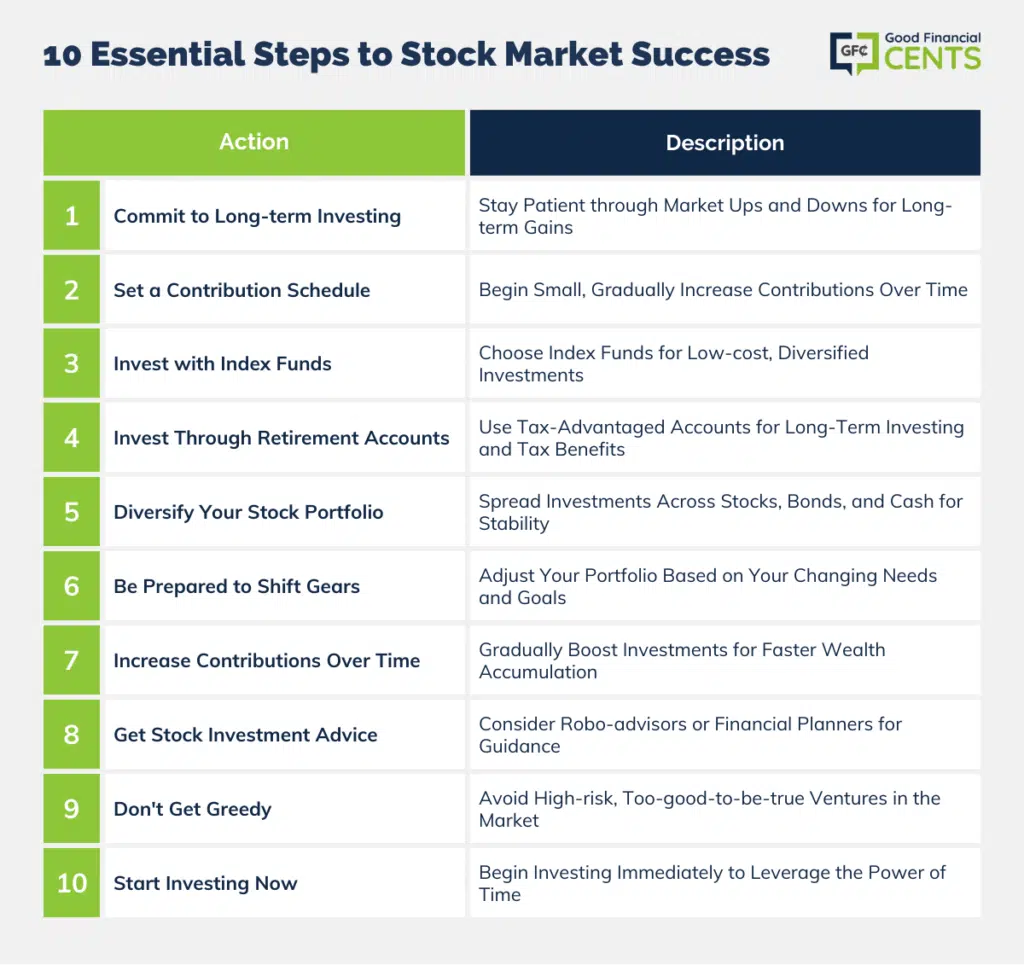It often seems as if everyone is looking for the secret sauce to get rich off stocks, and many other investments as well. In truth, there really are no secrets.
There’s nothing magic about investing in stocks, and no guarantees you’ll ever get rich.
But there are strategies you can use with the potential to greatly increase your wealth in the coming years.
Table of Contents
Is It Possible to Get Rich off Stocks?
In theory, yes. In reality, well – let’s just say that will take a lot of work and dedication. If it were otherwise, and especially if it were easy, everyone would be rich.
Since we know that’s not true, there must be something else involved. Closer to the truth is:
It is possible to get rich off stocks, but you’ll need an incredible amount of discipline and commitment to make it happen.
What you may be surprised to learn is it’s easier to get started than you might have guessed. Online investing has made the process both easier and more accessible to a larger number of people.
But don’t be fooled by the simplicity of the many investment platforms that are now out there. You’re still going to need to employ a lot of time-honored strategies, like:
- Living beneath your means.
- Saving money on a regular basis.
- Deciding on the right investment strategy, and
- Committing to it for decades – NOT just a few years.
That’s why we put together this list of 10 steps on how to get rich off stocks.
Getting Started on Your Journey to Stock Market Riches
Below are 10 steps to get you started on your journey to stock market riches. And even if you never get rich, it’s highly likely you’ll be in a much better financial position in a few years than you are right now.
1. Commit to the Journey – Become a Long-term Investor
Like most other moneymaking strategies, stocks are more of a get-rich-slowly process than get-rich-quick.
| If you invest $10,000 today at 10%, you’ll have $11,000 in one year. But if you invest $10,000 per year at 10% for the next 20 years, you’ll have $603,000. |
Most people would agree that $603,000 is a lot closer to rich than $11,000.
That means you should plan to begin contributions to your investment program now, with the expectation it will essentially become a lifestyle. That means investing over decades, not months or years.
The long-term commitment will also require you to adopt the right attitude.
Not only will you need to expect both outcomes, but you’ll also need to keep your emotions at bay.
For example, when the stock market is going strong, you may be tempted to invest 100% of your money in stocks, even in the most speculative kind, in an attempt to maximize your returns.
That may sound good and even work well during a raging bull market. But those don’t last forever. For this reason, you’ll need to maintain adequate diversification in your portfolio (which we’ll cover in Step #5 below).
At the opposite end of the spectrum, you’ll need to keep calm when the market isn’t cooperating. And rest assured, there are plenty of times when it won’t!

If your emotions are in control, you may sell your stocks to prevent losses. While the strategy might accomplish your goal in the short term, it could prove to be a disaster in the long term.
Most investment advisors recommend holding your investment positions through market downturns. That will avoid any attempt to time the market, which is virtually impossible anyway.
2. Set a Contribution Schedule and Stick With it
This is one of the hardest steps for most new investors. The cost of living is high and rising each year. Finding extra money in your budget to invest can seem like an impossible task. But it’s not, not as long as you set your sights low enough.
Low enough? Absolutely!
You don’t have to try to take the investment universe by storm by investing a lot of money upfront. You can open an investment account with no money at all, then begin investing gradually as you add funds.
You’ll get plenty of help from the investment industry. For example, the following investment platforms will allow you to open an account with no money at all, and then begin investing as you fund your account:
Any one of these investment platforms will enable you to set up recurring contributions, such as direct payroll contributions. That’s the easiest way to begin saving money since you’ll hardly notice the small amount taken out of your paycheck.
Once again, start small.
Though it may seem like a small amount, you’ll still be able to begin building momentum. When I first started investing, all I could afford was a paltry $25 per month I used to purchase an averaging performing mutual fund. It wasn’t a lot, but it was something.
Once you get started, no matter how small, you can build on that progress (we’ll cover how you can in Step #7 below).
If you’d like to begin investing immediately, fund your account with $100 or even $50. Some investment brokers, including some of those listed above, will allow you to trade using fractional shares.
Instead of buying a single share of a stock for $50, you can buy 1/50 for just $1. In theory, you could spread a $50 investment across 50 different stocks using fractional shares.
3. Invest With Index Funds
Index funds are the best way to invest for most people. They enable you to invest in an entire market or various market sectors.
For example, you can invest in a general market fund based on the S&P 500 Index. For the cost of a single share of an S&P 500 index fund, you’ll have a sliver of the 500 or so largest publicly traded companies in America.
Alternatively, you can invest in individual market sectors. Examples include energy, utilities, technology, biotechnology, and health care, among many others. You can also invest in index funds that specialize in foreign markets, like Europe or Japan, or emerging markets in Latin America and Asia. You can even choose index funds based on specific performance, like growth stocks or high-dividend stocks.
Index funds are designed to match the underlying index they’re tied to. This means they’re considered to be passive investments since they don’t actively trade stocks within the fund. The only time stocks are traded is if there are changes in the companies listed within the related index.
The low level of trading means index funds are less likely to generate capital gains income – which is generally taxable. And when they do, they’re usually long-term capital gains, which are taxed at lower rates, and sometimes at 0%.
Index funds also have the advantage they’re almost always available commission-free (unlike actively traded mutual funds, which have load fees as high as 3%). And since trading activity is so light, index fund expense ratios are also very low. In fact, they’re usually well below 1% per year.
Index funds won’t outperform the market, but they won’t underperform it either.
They’ll offer you a stress-free way to invest in stocks without having to choose individual companies or manage your portfolio.
4. Invest Through Tax-Sheltered Retirement Accounts
One of the best ways to invest in stocks is through a tax-sheltered retirement account. This includes an IRA (Roth or traditional) or an employer-sponsored plan, like a 401(k) or a 403(b).
Retirement accounts are excellent vehicles for stocks because not only are they a perfect way to invest on a long-term basis, but they also offer multiple tax benefits.
For example, contributions to traditional IRAs (but not Roth IRAs) and most employer-sponsored retirement plans are generally tax-deductible. You’ll be able to lower your tax liability each year you make contributions.
You can contribute up to $7,000 per year, or $8,000 if you are 50 or older, into a traditional IRA. For 2025, the maximum employee contribution to an employer-sponsored retirement plan has been increased to $23,000, or $30,500 if you are 50 or older. Meanwhile, many employers provide matching contributions to the plans, which adds thousands of dollars to your account each year.
The tax deduction you’ll earn on your contributions means at least some of your investment contributions will be covered by the tax savings.
But perhaps an even bigger tax advantage with retirement plans is the investment income earned within the plans is tax-deferred. That means the interest, dividends, and capital gains you earn on your investments are not taxable until you begin making withdrawals, usually beginning after age 59 ½.
Tax deferral means investment earnings of 10% will be retained in your plan, rather than being reduced by, say, 30% for income tax, with only 7% being retained. That will enable you to build your account balance much more quickly.
If you’re serious about investing in the stock market, and especially about getting rich, investing through a tax-sheltered retirement plan is one of the very best strategies.
5. Diversify Your Stock Portfolio
Diversification is a way to reduce the volatility in your stock portfolio, which ironically, can also improve long-term returns. There are several ways to diversify your portfolio.
The first is to diversify among stocks and stock sectors. If you’re investing in index funds, you’ll already be diversifying among stocks. That’s because index funds can hold stock in anywhere from dozens to hundreds of individual companies.
Among stock sectors, you may choose to invest some money in an S&P 500 index fund, while also holding positions in an international fund to gain global exposure. You may also want to invest in specific industry sectors you think are likely to outperform the general market. The investment industry gives you plenty of choice on that front.
The second form of diversification is to move some of your money outside of stocks.
That means you should be holding positions in cash and bonds, along with stocks. Cash and bonds will serve to minimize losses during stock market downturns, and provide you with the capital you’ll need to invest more money when the market begins to recover. (That’s part of how diversification can improve long-term returns.)
What allocation should you use?
Portfolio Diversification Formulas: 100 or 120 Minus Your Age
Two common formulas are 100 minus your age and 120 minus your age.
With the first, you subtract your current age from 100. If you’re 25 years old, 100 – 25 is 75. So at age 25, 75% of your portfolio should be invested in stocks, and 25% in bonds and cash.
120 minus your age is a more aggressive formula. By subtracting 25 from 120, you’ll get 95. That means 95% of your portfolio should be invested in stocks, with the remaining 5% in bonds and cash.
In a way, your formula will work to reduce your stock exposure as you get older. For example, using 100 minus your age, only 50% of your portfolio will be in stocks at age 50. The remaining 50% will be in bonds and cash.
Using 120 minus your age, 70% of your portfolio will be in stocks and 30% in bonds and cash at age 50.
Either formula reduces your exposure to stocks, and therefore, the overall risk of your portfolio, as you get older.
6. Be Prepared to Shift Gears When Necessary
We’ve just covered common formulas to determine portfolio allocations between stocks, bonds, and cash. But they are just guidelines, and you might even think of them as starting points. Choose either of the two and make adjustments as necessary.
For example, if you have a more conservative investment risk tolerance, you may want to go with 100 minus your age, then reduce the stock percentage even more until you feel comfortable.
(To help you better understand your personal risk tolerance, you can take the free Vanguard Investor Questionnaire. It will help you to understand if you have a conservative, moderately conservative, moderate, moderately aggressive, or aggressive risk tolerance.)
You should also be prepared to adjust your portfolio based on life circumstances.
For example, if you lose your job and anticipate a time of extended unemployment, or if you hit a medical crisis, you may want to reduce your stock allocation to create a more conservative portfolio.
There may also be certain macroeconomic developments, prompting you to make changes.
For example, let’s say bond yields rise substantially – all the way to 10%. Since you’ll be able to get a double-digit return, nearly risk-free, you may want to hold a larger allocation in bonds than you normally would. After all, while stocks may return 10%, they can also go in the other direction.
7. Increase Your Contributions Over Time
In Step #2 above we covered setting a contribution schedule. That will certainly get you moving in the right direction but don’t stop there. Just as the earlier you begin investing, the better your end result will be, the more you can invest the faster you’ll reach your goal.
Increasing your contributions doesn’t need to be a dramatic process, either. You can up your game gradually, over a number of years.
| For example, let’s say early in your investment journey you begin by contributing 5% of your salary to either your retirement plan, an investment brokerage account, or both. You can set a goal to increase your contribution by a single percentage point each year. |
Your 5% first-year contribution will become 6% in the second year, then 7% by the third year, and so on. After five years, your contributions will equal 10% of your pay. After 10 years, it’ll go up to 15%.
To minimize the impact of the annual increase, you can time the step up with your annual raise. So if your company increases your salary by 3%, you can allocate 1% of that to increase investing contributions.
If you’re really ambitious, you can increase your investment percentage by 2% per year. That will accelerate the ramp-up in contributions. For example, instead of taking five years to go from 5% to 10%, you can increase your contributions to 15% in the same amount of time with a 2% annual contribution increase.
Still Another Option: Investing in Windfalls
An excellent example is your income tax refund. With the average annual federal return at nearly $3,000, you’d be able to add several thousand dollars to your investment portfolio each year with what is practically found money.
Another example is to allocate bonus money toward investing. Since it’s likely you live on your regular salary, bonus income could more easily be allocated as a future investment. In that way, you’d be able to build your investment portfolio without disturbing your regular budget.
If you’re already gradually increasing the percentage of your regular pay you contribute to investments, adding windfalls to the mix will enable you to build your portfolio a lot faster.
8. Get Stock Investment Advice
If you know little about investing and don’t have the time to gain the knowledge needed, you have options.
The first is to invest through an online automated investment service, commonly referred to as a robo-advisor. They’re both easy and inexpensive to use. You can open an account online, complete a questionnaire that will help the advisor to determine your investment portfolio and fund your account gradually.
The robo-advisor will handle all the details, from portfolio creation to complete management. And they’ll do it all for a very low annual advisory fee, ranging from 0% to 0.40%.
Two excellent examples are Betterment and M1 Finance. Betterment is the better choice if you prefer complete investment management. They’ll create and manage your portfolio for a low fee of just 0.25% per year in most cases, leaving you free to go about the business of living your life.
If you’re comfortable choosing your own investments, like funds and even individual stocks, but don’t like managing a portfolio, M1 Finance may be the better choice. You can create individual portfolios, called “pies”, which you can stock with up to 100 stocks and funds. M1 Finance will then manage your pies with no annual fee.
The second way to get advice is to hire a financial advisor. There are various types, but you’ll want to favor hiring one who is a fiduciary. This is a financial advisor who is required by law to put your interests ahead of their own. They typically work on a flat fee basis and do not earn additional fees by putting you into certain investments.
But you should be aware that financial advisors usually work with higher net worth investors, typically those with over $100,000, and often a lot more.
9. Don’t Get Greedy!
It’s sometimes said that fear and greed are the twin emotions that drive the stock market, and it’s not too far from the truth. As an individual investor, you’ll need to guard against both.
For example, in a long-running bull market, you may be tempted to throw caution to the wind and start taking chances. That could cause you to get involved in high-risk activities, like day trading and penny stocks. Both have tremendous profit potential, but the reality is usually something much different.
I had a very bad experience buying a penny stock, which I documented in my article Penny Stock Debacle: How I Lost $5,000 and You Can (and Better!) Avoid It. You should read the article to be aware of the pitfalls of penny stocks. Unfortunately, the likelihood of losing money is much greater than the possibility of getting rich.
Penny stocks have a greater chance of making you poor than making you rich.
The same is true of day trading and virtually any type of investment activity that’s beyond what you feel comfortable doing. Tread lightly here, as there are many advocates claiming these high-risk activities are highly profitable and attainable by even average investors. But in reality, they’re not.
In one extreme example, a 20-year-old who began trading options on Robinhood, mistakenly believed he’d built a negative account balance of $-730,000. Perhaps believing the situation to be beyond repair, he took his life. You can read about it in Robinhood settles lawsuit over a 20-year-old trader who died by suicide.
Moral of the Story:
Let’s close this step with the time-honored advice: if it seems too good to be true, it probably is. That goes double for the stock market!
10. Start Investing Now, Right Where You Are
This is the final step, but it just as easily could’ve been the first. If you’re serious about becoming a successful stock investor, you’ll need to put time on your side. And since you don’t have yesterday, five years ago, or 10 years ago, now is the very best time to get started.
As we’ve already discussed, you can open an investment account with no money at all and begin investing as you fund your account. You can either begin with a few dollars or begin gradually making payroll contributions to your plan.
If you use index funds and fractional shares, you’ll be able to create a fully diversified portfolio, with a very small amount of money.
In short, the lack of money is no longer an obstacle to begin investing, not in today’s investment universe.
To emphasize the point, let’s compare two scenarios:
- You wait until you’re 50 to begin investing – when all things financial in your life are firing on all cylinders. You begin investing $20,000 per year at 7%. By age 65, you’ll have a little over $521,000.
- You’re 30 years old, and you begin investing now – even though your financial life is far from settled. You begin investing $5,000 per year at 7%. By age 65, you’ll have a little over $717,000.
Using the first scenario, you’ll have invested $300,000 of your own money and ended up with a portfolio of $521,000. But using the second scenario, you’ll invest just $175,000 of your own money, and end up with well over $700,000.
The point is, by beginning now – right from where you are – you’ll end up with more money from fewer contributions than if you wait until some future date when you have your financial life in order.
Got it?

Bottom Line on Getting Rich in the Stock Market
As is the case with all things great and wonderful in life, there’s absolutely no guarantee you’ll get rich off stocks. But the long-term averages are in your favor if you do invest, and you’ll have a much better chance of at least being in a better financial position in the future than you are right now.



